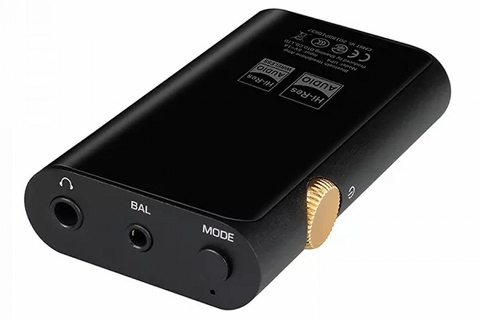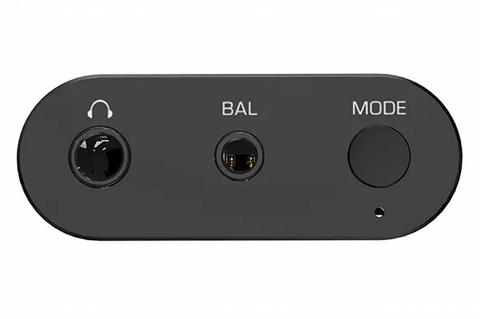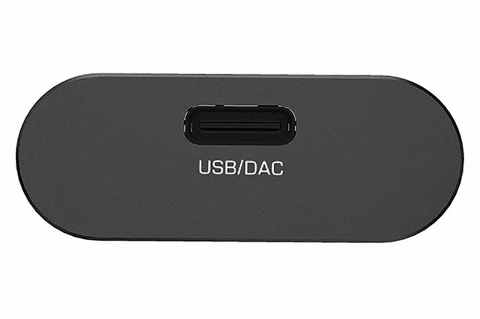about Audio, High Fidelity
& Home Entertainment technologies
pid: 607-2025/10/01 (v1.2)
Privacy Policy

When it comes to mobile devices, dimensions play an important role. A portable device must be small enough to fit in pockets or clip-on belts and be handy in the often uncomfortable - if not hostile - environment outside the home and on the go.
The case of the UP4 Ver.22 is interesting because it is very small (60x36x13.5mm), easily lost in a standard pocket and this is reflected in its rudimentary user interface: A rotary encoder together with a push switch takes care of everything, from the output level to the selection of gain and digital filters, while a multi-color LED informs the user of everything from the need for charging to the codec being used.
UP4 Ver.22 is a device with very small dimensions that fits comfortably in any pocket. It has two outputs for headphones, a standard, single-ended one with a 3.5mm jack, and a balanced one, with a 2.5mm jack. The user interface is minimal and based on a rotary encoder and a push button.
Although Shanling has made every reasonable effort to make the device easy to use, I'm pretty sure most people will prefer the app (which we'll talk about in a later paragraph).
Though bijou-sized, UP4 includes everything you need (and more…). It has two outputs for connecting headphones, a standard, single-ended TRS 3.5mm, and a balanced 2.5mm TRRRS as well as a USB-C port which can be used both to charge the device and to use it as a USB DAC for streaming from a computer. The battery has a capacity of 540mAh and gives a maximum autonomy of 15 hours, requiring a 2-hour charge.
The device is certified for both Hi-Res Audio and Hi-Res Audio Wireless. The second is due to its support of aptX HD (24/48).
On the side where the headphone outputs are located, there is also the microphone. It is a Knowles SiSonic that runs Qualcomm's noise canceling algorithm (cVc 8.0), to ensure high intelligibility of mobile speech.
In addition to being connected via USB-C, the UP4 Ver.22 can be connected wirelessly via either Bluetooth or NFC (Near-Field Communication) technology. In the second case, if one has a compatible source (a smartphone, a tablet, etc.), all that is needed is to approach the UP4 at a short distance. As far as Bluetooth is concerned, the device is based on Qualcomm's well-known SoC CSR8675, it supports version 5 and all the usual codecs, including aptX HD, which allows it to be certified as a HiRes Audio Wireless device. Through the USB-C connection, it can stream up to 24/96, which also leads to Hi-Res Audio certification. Quite curiously, Shanling points out that the USB-DAC can only be used in a Windows environment. The device also includes Knowles' SiSonic microphone, supported by Qualcomm's cVc 8.0 noise cancellation technology, for high-quality voice applications.
The device is charged via a USB-C port (it does not come with a charger) and can be connected to a computer, in a Windows environment, to stream files with a resolution of up to 24/96.
The app that supports UP4 Ver.22, Eddict Player, was a pleasant surprise. Well-designed and obvious to use, it gives access to the music material available to the user not only locally, on the smartphone, but also the home network. The virtual level meter is a bonus.
For the audio part, Shanling uses two d/a chips from ESS, (ES9219C). Based on the characteristics given by ESS themselves, the differences compared to the ES9218 (used in the original UP4) are not big with the lower power consumption being the more important, given that we are talking about a portable device. The output of each d/a chip is differential (the signal appears on two terminals with a phase difference of 180°) which offers Shanling the possibility to increase the output power through a mode it calls Dual DAC and is offered as one more option in the gain adjustment menu.
Through Eddict, the user can view and select the resources from which to extract files as well as configure device parameters. The app makes it particularly easy, because the user interface of the device itself, being very simple, may not be comfortable for some.
Previous | Next | More Reviews







